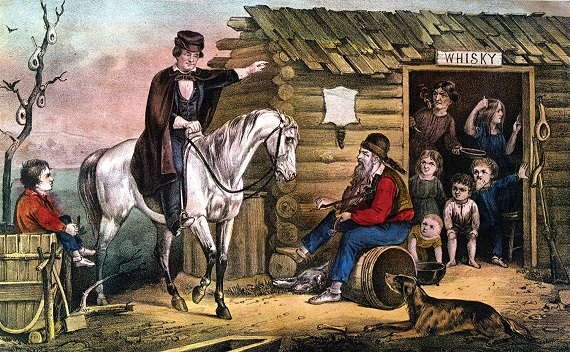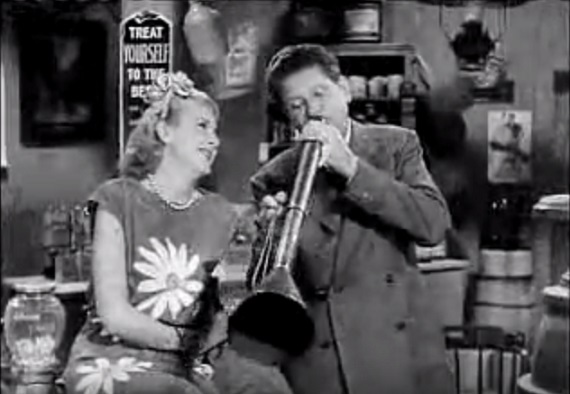It was Tuesday evening, September 16th, and people all across America were settling down for the first performance of a new CBS comedy and music program. Rather than watching the show on fifty-inch TV screens with names like Sony, Samsung and Panasonic, since the year was 1941, they would be gathered in front of AM radio sets bearing such then familiar names as Philco, Emerson and RCA. In Little Rock, Arkansas, they would be tuned to their local CBS affiliate, KLRA , the “Voice of the Wonder State,” to hear the new program called “The Arkansas Traveler” starring one of that State’s favorite personalities, Bob Burns. The show was a combination of a humorous, homespun Southern monologue by Burns and a situation comedy filled with an array of Burn’s fictitious relatives and neighbors from his home town of Van Buren, as well as novelty music provided by Spike Jones and His City Slickers and popular songs by the big-name band vocalist from Texas, Ginnie Simms.
Burns had initially created the persona of the Arkansas Traveler for his stage act a few years after serving as a Marine Corps sergeant in World War One. Prior to that, while still a teenager in Van Buren, he had played various brass instruments in the Queen City Silver Cornet Band, as well as working in a plumbing supply shop where he put together an unique musical instrument that he later included in his comedy act. The instrument, which he dubbed the “Bazooka,” was made from a simple metal gas pipe, some heavy wire and a large whiskey funnel. Because of its shape, the term “Bazooka” was later used as the nickname for the Army’s M-1 shoulder-held rocket launcher that did much to stop German panzers in World War Two, but more on that later.
Bob Burns was a true son of the South. His grandfather, John Barnabas Burn, was born in South Carolina in 1823 and about 1840 he traveled west to Tuscaloosa, then the Alabama State capital and a thriving boom town filled with hotels, restaurants, saloons, gambling halls, theaters and other forms of entertainment. This all came to an abrupt end in 1846 when the capital was moved to Montgomery and all the politicians, lobbyists and gamblers, as well as most of the entertainers and saloon keepers left along with it. 1846 also saw the start of the Mexican War, and John Burn left as well to enlist as a private in the Second Louisiana Militia. After the War, he returned to Tuscaloosa, became a shoemaker and in May of 1849 married Hariett Drawhorn in nearby Bibb County. By the time their first son William Robert . . . Bob Burn’s father . . . was born in 1851, Tuscaloosa’s population had not only been restored but increased, and it had been transformed from a city of high jinks to a seat of higher learning led by the twenty year old University of Alabama which had taken over the empty capital building. William Burn became a civil engineer, married Emma Needham from Tennessee and the two later relocated to Greenwood, Arkansas, where their first child, Robin William, was born on August 2, 1890. When Robin was three, the family moved again to the small city of Van Buren on the Arkansas River.
Young Robin first attempted to follow in his father’s footsteps by studying civil engineering but later worked as a river ferryboat pilot, then a hay salesman and finally turned his hand to peanut farming. However, he soon realized that his future belonged in the world of entertainment and spent the next few years performing various types of comedy and musical acts in vaudeville and minstrel shows under the name Bob Burns. Burns returned to the stage after World War One and in the late 1920s he traveled west to California where, in 1930, he started a new career at a Los Angeles radio station on a comedy program called “The Fun Factory.” Five years later, Burns headed for New York to appear on Rudy Valley’s show, “The Fleischmann’s Yeast Hour,” on which he performed a Will Rogers-type monologue. While on the program, Burns became friends with bandleader Paul Whiteman who later introduced him to Bing Crosby back in Los Angeles. The meeting led to a five-year contract with Crosby’s “Kraft Music Hall” as the Arkansas Traveler, the name he had taken years before based on the song and stories created by another well-known teller of humorous Arkansas tales, Colonel Sanford “Sandy” Faulkner.
Faulkner was born in Scott County, Kentucky, on March 3, 1806, but in 1829 the family relocated to Arkansas where they established an extensive cotton plantation at Point Comfort in Chicot County and became the largest slaveholders west of the Mississippi River. In 1831, Faulkner was appointed as aide-de-camp to Brigadier General Richard Byrd, the commander of the Arkansas Militia’s Second Brigade, and given the rank of colonel, a title by which he was known for the rest his life. After that, Faulkner became active in Arkansas politics but was unsuccessful in his attempts to win election to either the Territorial or State Legislatures. After piling up massive debts in 1839, Faulkner moved to Little Rock when his plantation and slaves were seized and sold to meet his obligations. It was during this period, however, he attained lasting fame by composing the violin tune he called “The Arkansas Traveler.” The piece was named for a settler Faulkner had met while on a political tour, and about whom Faulkner told many stories that later became part of Arkansas folklore. The tune also served as the State song from 1949 to 1963, and has been the State’s historical song since 1987. Then, in 1858, Faulkner’s stories and song about the “Arkansas Traveler” provided the inspiration for the well-known painting of that name by Edward Washburn which was used a decade later in a popular Currier and Ives lithograph.
When Arkansas seceded from the Union in 1861, the State seized the Federal Arsenal in Little Rock and appointed Faulkner as the facility’s military storekeeper. He remained at that post until Little Rock was retaken by Federal troops in 1863, whereupon he fled to Tyler, Texas, and stayed there until the end of the War. Later in 1865, Faulkner returned to Arkansas and tried to start a farm, but lacked the funds to purchase sufficient land or hire workers. He was to survive in ill health and virtual poverty at his home in Little Rock until his death on August 4, 1874. His funeral was attended by two former governors, Henry Hector and Harris Flanagin, as well as a future governor, Thomas Churchill, and many other prominent Arkansans. As a further tribute to Faulkner, when the State’s sixty-ninth county was created it was named in his honor. A decade later, a nationally famous author who used Arkansas as the setting for many of his novels and who had been the editor of both the “Little Rock Evening Post” and “Little Rock Gazette,” Opie Read, founded his own humor magazine which he named the “Arkansas Traveler.”
Returning to Bob Burns, his show, “The Arkansas Traveler,* was aired for two seasons on CBS, with the second season starting on October 7, 1942, and running until the last episode on December 30th. On January 7th of the following year, however, a new program, “The Bob Burns Show,” was created and moved to Thursday evening on NBC’s Red Network, later renamed the American Broadcasting Company, and remained there until its final broadcast on May 25, 1947. For the next eight years Burns continued to make guest appearances on a number of radio and television shows, the last being Ed Sullivan’s “Toast of the Town” in 1955. Burns also made two failed attempts to revive shows similar to “The Arkansas Traveler” prior to his death in Encino, California, on February 2, 1956.
Except for devotees of old-time radio recordings, the Arkansas Traveler may well have been largely forgotten by the majority of today’s generation, but the memory of Bob Burns’ most unusual musical instrument, the Bazooka, still lives on in the many books, movies and television shows dealing with World War Two. That famed rocket launcher, however, was certainly not the first instance of such a weapon. The first recorded use of rockets for military purposes actually dates back to Thirteenth Century China when the forces of the Sung Dynasty used rockets fired from bamboo tubes to repel the Mongolian invaders. Five centuries later in India, the troops from Mysore launched the first rockets to be fired through iron tubes at the British during the Battle of Guntur in 1780. The technology was soon adopted by the English and in 1805, William Congreve developed a much improved weapon that was first used against Napoleon and then against America in the War of 1812 with one bombardment being forever immortalized at Baltimore’s Fort McHenry in 1814 by Francis Scott Key’s line from the “Star Spangled Banner” . . . “the rockets’ red glare.”
Another Englishman, William Hale, developed an even far more efficient rocket in 1844 which was first used by the United States Army two years later during the Mexican War. Due to the great advances in artillery during the next decade, particularly rifled and breech-loaded cannons, the use of rockets as a weapon greatly declined. Some, however, were used by the Confederate Army during the War Between the States, the first on July 3, 1862, during the Peninsular Campaign in Virginia when General J. E. B. Stuart’s Horse Artillery fired rockets into General McClellan’s retreating troops at Harrison’s Landing. Similar rockets and launchers that were made in Galveston and Houston were later used effectively in several engagements by Confederate troops in Texas. Prior to that, the Union, under the direction of a British officer, Major Thomas Lion, organized the hundred and sixty man New York Rocket Battalion in December of 1861. Even though the North’s missiles had a range of up to three miles, they proved to be so erratic and inaccurate that they were never actually used in battle. A few rockets, however, were fired by Union troops to help drive away Confederate picket boats during the siege of Charleston, South Carolina.
Today, however, while rockets are now being used to explore the far reaches of the Universe and place communication satellites into outer space, as well as lighting up the sky on the Fourth of July, there is also an ever-growing proliferation of nuclear-armed missiles that can be fired all too accurately from one continent to another. Sadly, there is as well a deepening dearth of the type of homespun Southern humor that was once provided by Bob Burns and enjoyed by all America for almost forty years. If we could only, to paraphrase announcer Fred Foy’s classic lines when introducing another famous old radio program, “The Lone Ranger,” return with us now to those thrilling days of yesteryear. From out of the South came the wondrous humor of the late Bob Burns. The Arkansas Traveler rides again.







